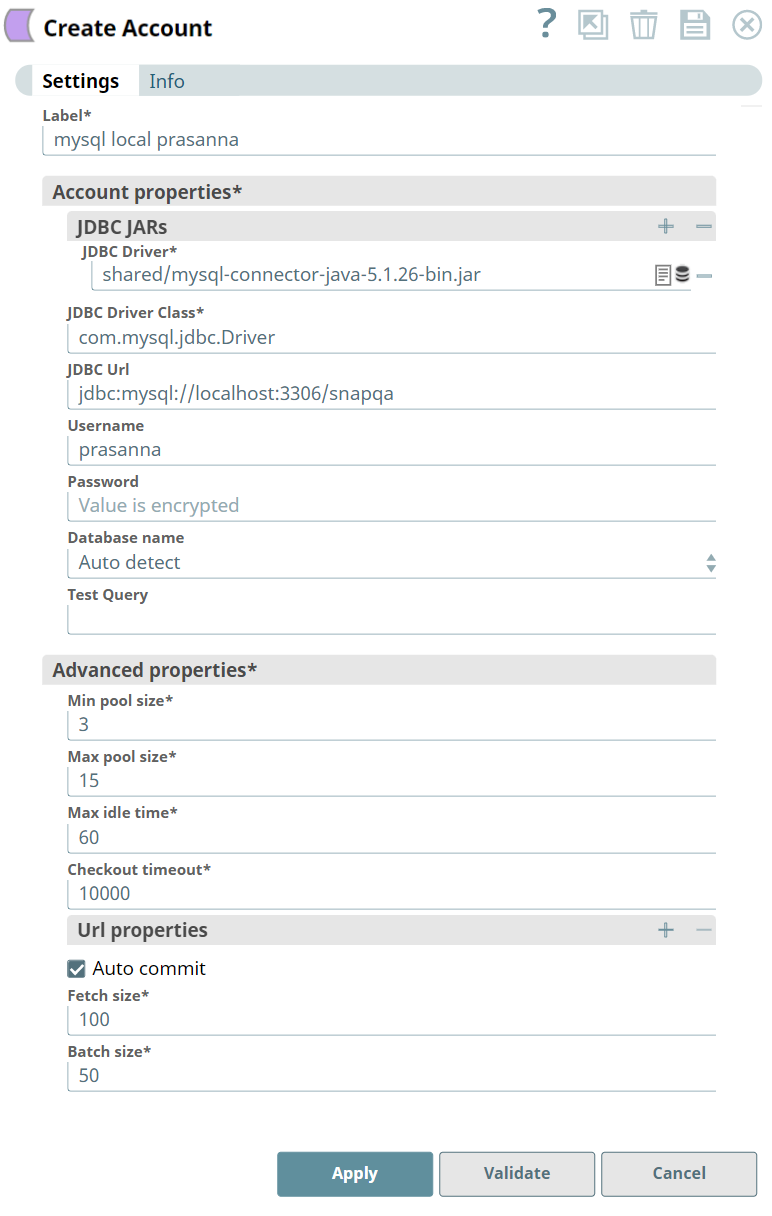In this article
...
- Use the Informix JDBC driver version 4.50.4.1 or a higher version.
- Configure the following URL properties in the account settings:
- Url Property name: IFMXCONNECTION_CLEANER_THREADS
- Url property value: 0
Account Settings
| Note |
|---|
Field names marked with an asterisk ( * ) are mandatory. |
...
Field Name | Field Type | Description | ||||
|---|---|---|---|---|---|---|
Label* Default Value: N/A | String | Specify a unique label for the account. | ||||
| Account properties* | The information required to create a connection to the database. | |||||
JDBC JARs | Use this field set to define JDBC Drivers. This field set consists of the JDBC Driver field. | |||||
JDBC Driver* Default Value: N/A | String/Expression | Specify the JDBC driver to use. Click the Upload icon to upload the JDBC driver that you want. Click Add to add a row for specifying a JDBC driver. Specify each driver in a separate row.
| ||||
JDBC Driver Class* Default Value: [None] | String/Expression | Specify the JDBC Driver class name to use. | ||||
JDBC URL Default Value: [None] | String/Expression | Specify the JDBC URL to use. | ||||
Username Default Value: N/A | String/Expression | Specify the database username to use. | ||||
Password Default Value: N/A | String/Expression | Specify the database password to use. | ||||
Database name Default Value: Auto detect | String/Expression | Choose a database to which the account must be connected. The available options are:
If you use PostgreSQL JDBC driver to connect to Redshift database, the Auto detect option automatically detects the PostgreSQL database instead of Redshift. The behavior of the JDBC Snaps is optimized for the selected database. | ||||
Test Query Default Value: N/A | String/Expression | Activates on selecting Auto detect for Database name. Specify a custom query to validate the database connection.
| ||||
| Advanced properties* | ||||||
Min pool size* Default Value: 0 | Integer/Expression | Specify the minimum number of idle connections a pool will maintain at a time.
| ||||
Max pool size* Default Value: 15 | Integer/Expression | Specify the maximum number of idle connections a pool will maintain at a time. | ||||
Max idle time* Default Value: 60 | Integer/Expression | Specify the number of seconds a connection will exist in the pool before being destroyed. | ||||
Checkout timeout* Default Value: 10000 | Integer/Expression | Specify the number of milliseconds to wait for a connection to be available in the pool. A timeout of zero makes the Snap wait infinitely. After a certain time, an exception is thrown and the Pipeline fails. | ||||
| Url properties | Use this field set to define URL properties to use in the JDBC URL. | |||||
Url property name Default Value: N/A | String | Specify the name for the URL property. | ||||
Url property value Default Value: N/A | String | Specify a value for the property name. | ||||
Auto commit Default Value: Selected | Checkbox | Select this checkbox to commit a batch immediately after the batch executes. So, only the current executing batch will be rolled back if the Snap fails. | ||||
Fetch size* Default Value: 100 | Integer/Expression | Specify the number of records to retrieve from the DB at a time. | ||||
Batch size* Default Value: 50 | Integer/Expression | Specify the number of query statements to execute at a time. SELECT queries are not batched.
| ||||
...

